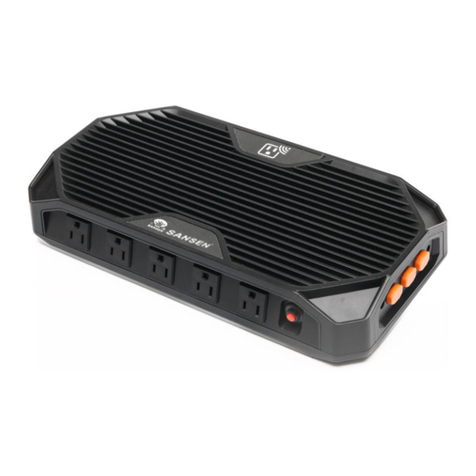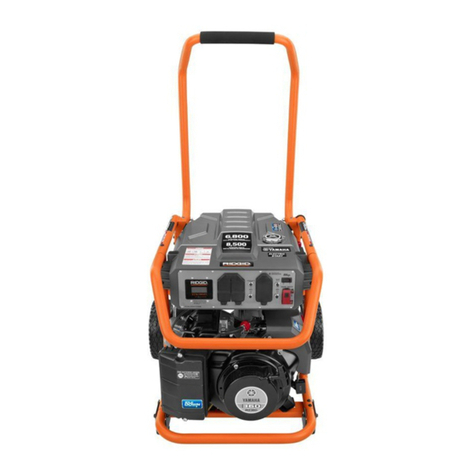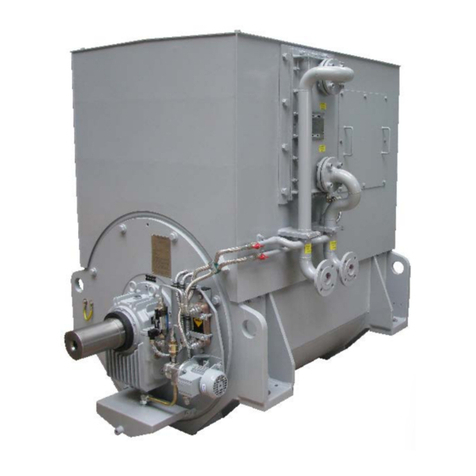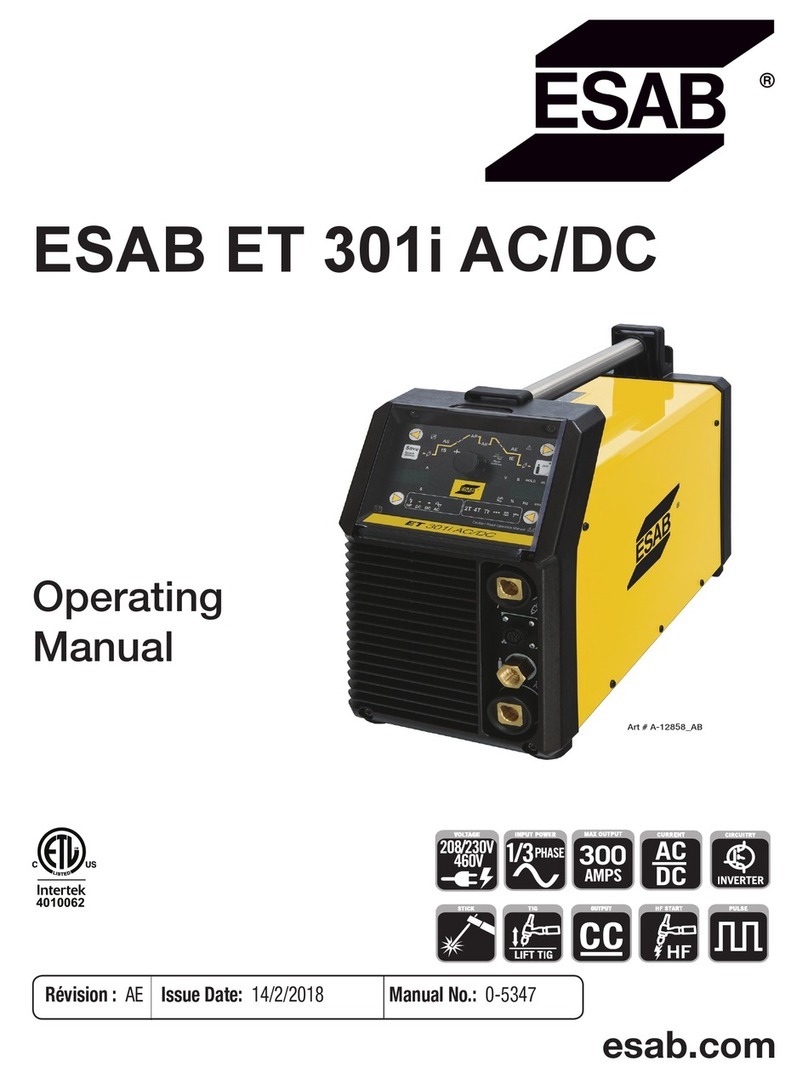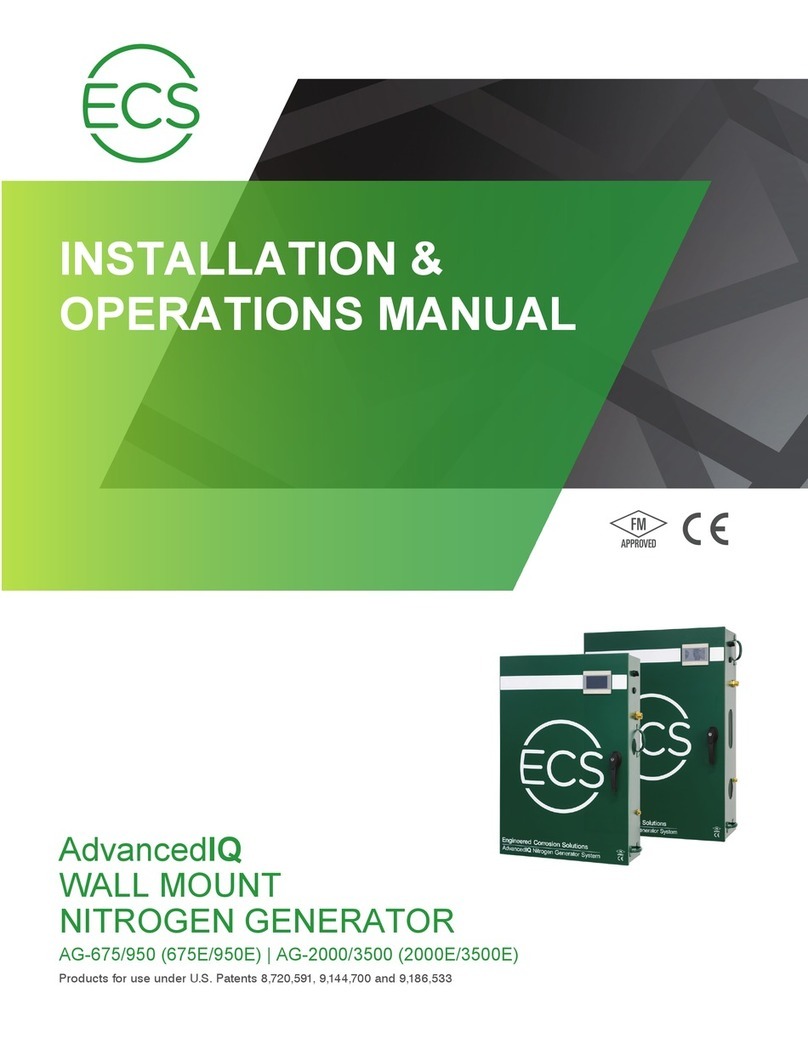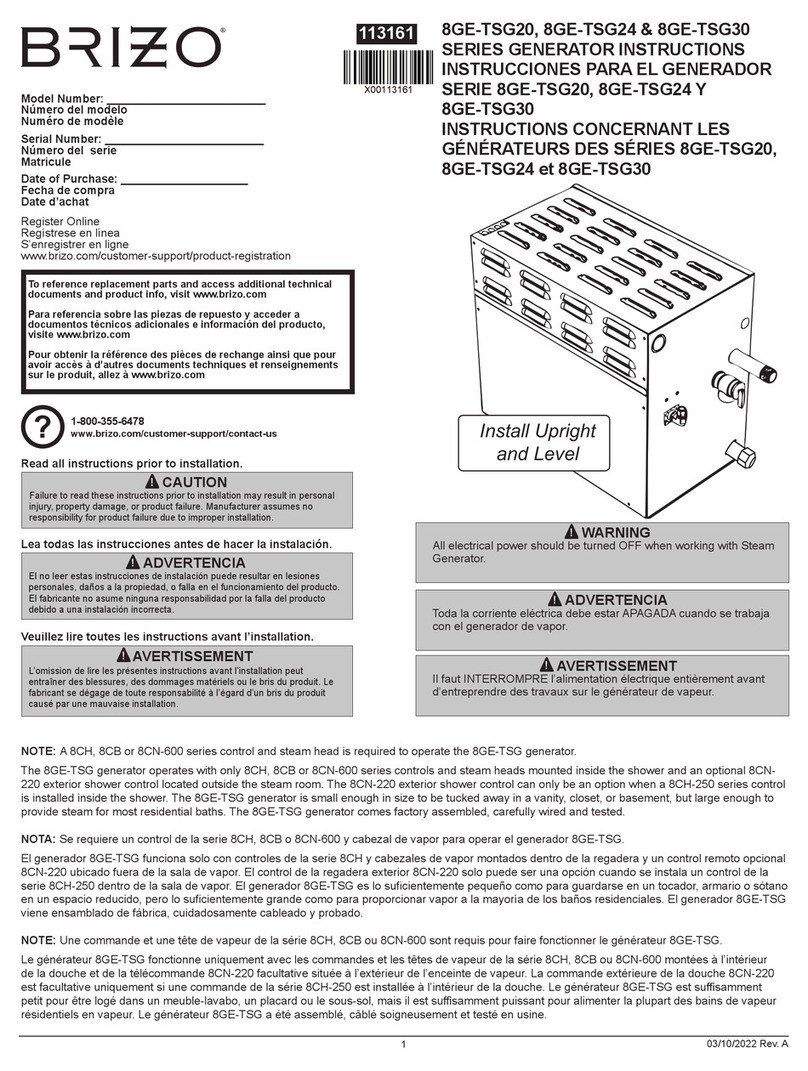Baur SSG 1100 User manual

User manual
Surge Voltage Generator
SSG 1100
SSG 1500
SSG 2100
SSG 3000
Ident. Nr. 822-017 02/2014
Raiffeisenstrasse 8, A-6832 Sulz/Austria internet: www.baur.at Fax +43/5522/4941-3

2

3
Guide to this Operating Instruction
Copyright
Preface
Safety precautions
For fast finding of important information the
corresponding text passages are marked with symbols
(symbols not stated here are self-explanatory).
More and special information concerning the
respective subject are available from BAUR.
Important information about the
instrument!
In any case, read carefully!
Important information text.
This manual contains all information necessary for
the correct handling and operation of the
described system. Before using the system please
read carefully this User Manual. If you have any
questions please contact directly:
© BAUR Prüf- und Messtechnik GmbH, A-6832-
Sulz / Austria
All rights reserved.
No part of this publication may be reproduced,
transmitted, stored in a data processing system or
translated into another language without the
written permission of BAUR / Sulz, Austria.
In the interest of our customers we reserve the
right for modifications due to technical progress.
Illustrations, descriptions and delivery content are
therefore not binding.
BAUR Prüf- und Messtechnik GmbH, Raiffeisenstrasse 8
A-6832 Sulz / Austria
or refer to your nearest BAUR representative.
Tel. +43/5522/4941-0
Fax. +43/5522/4941-3

4
It is imperative to every person who is involved with the installation,
start-up, operation and maintenance to have read and understood
the complete Operating Instruction.
It is the responsibility of the customer to ensure that only
authorized persons may be allowed to use the surge voltage
generator.
Only authorized personnel! The user
- is qualified and properly instructed and has
the necessary experience.
- knows the relevant standards, accident
prevention rules and operating conditions.
- is able to carry out the necessary operations
and is aware of the possible dangers involved.
- must immediately inform his superior about
any conditions of the unit that could affect safety.
The surge voltage generator is used for cable fault location at layed
power cables!
Any other or additional use is deemed to be in contravention of the
intended use. The manufacturer shall not be liable for damage
resulting from any such use. In such a case the risk shall be borne
solely by the user.
The local safety and accident prevention rules are always
applicable to the operation of the surge voltage generator unit.
Especially the surge voltage generators may not be used in
potentially explosive atmosphere or at test objects which are in
service.
Danger! High-voltage
When using surge mode:
Cordon off surge voltage generator at a distance of 1.5 m
Persons must stand only outside the barrier
Warranty
At the customer’s written request we undertake to repair or replace at
our discretion and as quickly as possible all parts that become faulty as
the demonstrable result of poor material, faulty design or defective
workmanship. We shall bear the costs of any faulty parts requiring
replacement, but not the costs of transport to us and back to the
customer, nor the costs of packing and insurance! The
12 month warranty time starts from delivery. We shall not be liable for
any damage resulting from normal wear and tear, improper handling,
non-observance of Operating Instructions and safety regulations. We
shall also refuse to accept any liability if the customer carries out
repairs or changes to the unit themselves or has others carry them out!
The warranty does not cover damage in transit, batteries, fuses and
any readjustments in accordance with the Operating Instructions!
We draw attention in addition to the ‘General Sales and Business
Conditions’ of:
BAUR Prüf- und Messtechnik Gmbh Raiffeisenstrasse 8,
A-6832-Sulz / Austria

5
Contents
1Product Information ...............................................................................................6
1.1Design and function ...............................................................................................6
1.2Display and operating elements ...........................................................................7
1.3Technical data.........................................................................................................9
2Packing and Shipping ..........................................................................................10
3Placing into operation..........................................................................................11
3.1Operating modes ..................................................................................................11
3.2Connection of instrument....................................................................................13
3.3Connection to mains ............................................................................................15
3.4Switch on...............................................................................................................16
3.5Switch off ..............................................................................................................17
3.6Discharge ..............................................................................................................17
3.7EMERGENCY SWITCHING OFF...........................................................................18
4Servicing / Maintenance.......................................................................................19
4.1Safety precautions ...............................................................................................19
4.2Fuses .....................................................................................................................19
4.3Breakdown voltage of spark gap ........................................................................20
4.4Checking the discharge unit ...............................................................................21
4.5Replacing high voltage connecting lead............................................................21
5Options, Accessories and Ordering Information ..............................................22
5.1Options ..................................................................................................................22
5.2Accessories ..........................................................................................................22
5.3Ordering information SSG 1100 ..........................................................................23

6
1 Product Information
1.1 Design and function
Design
Instruments of the SSG family are rack mounting units in the 19" format. Various operating and
indicating elements are mounted on the front panel, connecting elements are mounted on the
back plate. The instruments contain their own high voltage generator, impulse-proof surge
capacitors, automatic and manually triggered spark gaps and an internal discharge device. The
instrument control contains the necessary safety circuits also for connection of an external
Emergency Stop unit and for the operation of the SA 32 option
High voltage generation
Mains is connected to a variable transformer which supplies the primary winding of a H.V.
transformer. The secondary windings of the high voltage transformer features four high voltage
windings, fully isolated of each other, which are connected each to a partial
capacitor through a half-wave rectifier. Using the range selector switch (15) the partial capacitors
become connected to each other. The series connection allows a maximum voltage of 32kV. The
connection of two capacitors each in series and parallel allows a
maximum 16kV and the complete parallel connection of the capacitors leads to a maximum
voltage of 8kV. In this configuration it can be accomplished, that the maximum surge energy of the
capacitors is available in three voltage ranges.
Function
The Surge Voltage Generators SSG 1100, SSG 1500, SSG 2100 and SSG 3000 are designed in
such a way that they generate pulse-shaped voltages with a steep edge, which should start to
break down the cable fault. The high surge current flowing at the cable fault
generates electromagnetic and acoustic waves which radiate from the cable fault. These waves
can be detected on the ground surface with appropriate detection devices such as search coils or
ground microphones. The SSG 1100, SSG 1500, SSG 2100 and SSG 3000
however can also be implemented for pre-location. In this case they are used as burn down
device for short time operation or they can be used with an echometer and the SA 32.

7
1.2 Display and operating elements
Front panel
1Mains switch as overload protection switch with thermal tripping
2 Push button switch „Ready to switch on“ ( )
3 Push button switch „H.V. On“ ( I ) with indicator lamp for high voltage clearance.
The indicator lamp serves as feedback for the operating state „IN OPERATION“
4 Push button switch “H.V. OFF” ( ) returns instrument state to
„READY FOR OPERATION“.
5 Voltmeter of class 1.5 for display of output voltage in kV
6 Mode selector switch for selecting operating modes "Fast impulse sequence", "Slow
impulse sequence", "Single impulse triggering", "D.C. operation".
7 Push button switch for single impulse triggering
8 Red indicator lamp for feedback of operating condition „READY TO SWITCH ON“ and
„IN OPERATION“
9 Green indicator lamp for feedback of operating condition „READY
FOR OPERATION“
10 EMERGENCY OFF switch pushbutton (lockable) for activating the EMERGENCY
OFF function and to protect against unauthorized switching on
11 Range selector switch for voltage ranges 8 / 16 / 32 kV
12 Variable transformer for varying the output voltage according to the voltage ranges
selected with the range selector switch
13 Overload protection switch with thermal and magnetic tripping
14 Fuse F4 (3,15A slow-blow) for control of lifting magnet and control of SA 32 (option)
15 Fuse F3 (3,15A slow-blow) for control of lifting magnet and control of SA 32 (option)

8
16 Connection socket for external EMERGENCY OFF unit with jumper plug
17 Connection for mains to SA 32
18 Connection for mains
19 Terminal for connection of protective earth lead
20 Spark gap
21 Shorting bar for bridging the spark gap during D.C. operation
22 Knurled nut for H.V. connection
23 Knurled nut for station earth connection
24 Connecting lead to discharge unit
25 Mounting screws for electrode support
26 Type plate
27 Danger sign
28 Safety cover for protection against direct and indirect contact
29 Mounting screws for protective hood
30 High voltage connecting lead

9
1.3 Technical data
SSG
1100
SSG
1500
SSG
2100
SSG
3000
Unit
Mains voltage see type plate V
Mains frequency 45 to 60 45 to 60 45 to 60 45 to 60 Hz
Max. power consumption
(at short circuit condition)
3000
5000
5000
5000
VA
Max. output voltage 32 32 32 32 kV
Max. surge energy 1100 1536 2048 3000 Ws
Accuracy of kV-meter
1,5
1,5
1,5
1,5
%
Dimensions of housing
(W x H x D)
ca 514 x 654 x 730
514x654x880
mm
Weight
79 126 147 kg

10
2 Packing and Shipping
The instruments are shipped in robust cardboard cartons on wooden pallets. If the instruments are
not used immediately, always keep in closed carton and store in dry rooms!
Damage during transport
Complaints concerning damages should be made to us without delay, using a standard transport
damage claims form.
Confirmation of visible damage should immediately be obtained from the carrier.
The extent and the probable cause of damage should be stated.
If damage is discovered during unpacking, contact the responsible transportation company
immediately. Request a written loss assessment and make them responsible for the damage! We
also refer to the “General Terms of Sale and Delivery„ of:
BAUR Prüf- und Messtechnik GmbH
A-6832 Sulz/Austria

11
3 Placing into operation
The surge voltage generators of the SSG family are primarily intended for
use in the field of power cables. Do not use them for data transmission
cables or communication cables!
3.1 Operating modes
Impulse operation
The impulse operation serves first of al for fault locating and is divided into manual and automatic
impulse triggering. The mode selector switch (6) allows to switch between positions „Manual
impulse sequence“, „Slow impulse sequence“ and „Fast impulse sequence“ even during
operation and under voltage.
Manual impulse triggering
Manual impulse triggering is primarily intended for application of the surge voltage generator in
pre- locating, as for example in connection with the Intercom SA 32 (option) and the echometer.
By applying the secondary impulse method in high resistance faults, an assessment of the fault
distance with one or a few impulse trigger actions can already be made.
Turn mode selector switch (6) into position 0.
- The pushbutton switch for single impulse triggering is now activated. The spark gap
can be activated by pressing the pushbutton switch as soon as the instrument is in
the operating condition "READY TO SWITCH ON".
Automatic impulse triggering
Automatic impulse triggering is primarily used for pin-pointing a cable fault.
The SSG 1100, SSG 1500 and SSG 2100 are equipped with a timer coupled to the mains
frequency which allows for automatic impulse triggering with impulse frequencies of 10/min and
20/min. The timely regularity of the subsequent impulses serves to better differentiate between
the signals of the fault location and interferences.
Depending on different surge capacities and performance of instruments the following
impulse frequencies (per minute) are available at 50 Hz.
Mode selector switch SSG
1100
SSG
1500
SSG
2100
SSG
3000
Slow impulse sequence 10 / min 20 / min 10 / min 10 / min
Fast impulse sequence 20 / min 30 / min 20 / min 15 / min
Turn mode selector switch (6) to the left position "Slow impulse
sequence" or to the fully left position "Fast impulse sequence".
- Once the instrument is in the operating condition „READY TO SWITCH ON“ it closes
the spark gap automatically according to the appropriately selected impulse sequence.

12
DC operation
The Surge Voltage Generator can be put into D.C. operation via the
mode selector switch (6).
Turn mode selector switch (6) to the fully right position =.
- The shorting bar bridges the spark gap and as a result the
H.V. output is directly connected with the surge capacitor.
Fault location
In D.C. operation, with the surge capacitors connected, the voltage is increased until the cable
fault breaks down. This mode of operation is recommended especially for estimating the
breakdown voltage in order to conduct an optimal range selection for the
impulse operation. In combination with the SA 32 option and the echometer, the D.C. operation
can also be implemented in prelocating of cable faults.
Testing
D.C. voltage tests can also be conducted in the D.C. operation. It is however important that the
connected surge capacity, in case of a breakdown, is discharged through the fault location and
that the surge generator switches to burn down operation. The instrument
protects itself from overloads switching off automatically after a certain time by the overload
protection switch (14). During short term operation, maximum output currents can be found during
the burn down process according to the following table.
max. output current (IMAX)
Range selector switch SSG 1100 SSG 1500 SSG 2100 SSG 3000
in 8 kV position 560 mA 850 mA 850 mA 850 mA
in 16 kV position 280 mA 425 mA 425 mA 425 mA
in 32 kV position 140 mA 210 mA 210 mA 210 mA
In connection with the Intercom SA 32 (option) with mA-meter the output current can be measured
and be adjusted by changing the output voltage through variable transformer (11). Additionally,
there is a possibility to limit the output current by a high-power resistor.

13
3.2 Connection of instrument
Observe correct position of connection terminals!
(also see Note on page 14)
Connection to a single-phase shielded cable
Connection of a three-phase shielded cable
Connection to a three-phase unshielded cable with neutral
1. Rear view of device
2. High voltage connection cable
3. Protective ground cable
4. High voltage connection cable conductor
5. High voltage connection cable screen
6. Station ground
- Protective ground connection
- Operating ground connection
Pulse current flow

14
Preparing test object
Isolate the test object
Lock against reconnection
Make sure that zero voltage condition exists.
Insulate nearby items which are under voltage
It must be assured that nearby items of the station or cable system under voltage do not
result in breakovers or breakdowns, due to applying surge or D.C. voltage of the surge
generator to the test object.
Connect all strands in the cable station, with the exception of the fault afflicted strand, to
the station earth.
Attention! Wire size and insulating capacity of the cable system must be in an appropriate
relationship to the amplitude of surge voltage and to the surge energy. Otherwise,
overloading to the still intact parts of the system might occur.
Connecting the protective ground
Connect the surge voltage generator with the station ground through the protective ground
connection (19) on the rear plate of the device.
Attention! Connect the protective ground cable as close to the station ground
connection as possible (see connection examples on page 13).
The protective earth lead should be kept as short as possible and must have low impedance
(min. cross section 10 mm², copper).
Connecting the operating ground
The high voltage connection cable screen is used as operating ground.
The operating ground closes the electric circuit and is used for the return
cable of the impulse current!
Connect the operating ground carefully because it must withstand the full
surge current. Observe the correct terminal position!
Connect the high voltage connection cable screen (operating ground connection) to the
station ground. Select the location for the connection of the screen to the station ground as
follows:
- as close as possible to the location where the test object screen is connected to the
station ground and
- as close as possible to the location where the test object conductors that will not be
tested are connected to the station ground (see connection examples on page 13).

15
Estabilshing H.V. connection
Connect strand of the high voltage connecting lead with the fault afflicted strand of the test
object.
It is very important that all connections are of low resistance as possible.
Bad connections can lead to weldings or contact wear.
At the instrument, protective earth and station earth may not be connected
with each other. Otherwise, this would be result in an increase of potential
and possible danger due to the high impulse flow. In the instrument the
station earth is isolated from the protective earth up to an impulse voltage of
16 kV in order to avoid a flow of current via the protective earth line resulting
in a voltage drop.
Install external EMERGENCY OFF unit (option) at appropriate location and plug in the
connection plug instead of the jumper plug (16) on back plate of surge generator.
3.3 Connection to mains
Mains operation
Connect instrument to mains supply using appropriate mains voltage and minimum fuse rating.
The protective conductor of the mains supply must have the same
potential as the station earth!
Operation with emergency power generator
The generator must have adequate power to meet the maximum power requirements of the
instrument (see technical data) without break down of voltage or frequency, due to its load.
Otherwise, it could happen that the instrument will be switched off automatically.
Set generator voltage according to mains voltage as indicated
on type plate and connect instrument.
The separate network may not be electrical isolated but must
be connected to protective earth!

16
3.4 Switch on
Danger! High-voltage
When using surge mode:
Cordon off surge voltage generator at a distance of 1.5 m
Persons must stand only outside the barrier
Turn variable transformer (11) to its left position.
Set range selector switch (15) to the desired range 8 /16 /32 kV.
Pull out knob, turn to desired position and push back to its stop.
Switch on mains switch (1)
The instrument is in operating condition "READY FOR OPERATION"
→the green indicator lamp (9) is illuminated
Press pushbutton switch „Ready to switch on“ (2). In case the overcurrent protection
switch (14) has tripped, a buzzing sound occurs during depression of the „Ready to switch
on“ (2) pushbutton switch. Activating the pushbutton
switch is accepted by the instrument only if
→the overcurrent protection switch (14) has not been tripped
→the EMERGENCY OFF switch (10) is not activated,
→the external EMERGENCY OFF unit (option) was not activated resp.
The jumper plug is plugged in on the back plate.
The instrument is in operating condition „READY TO SWITCH ON“.
→the green indicator lamp (9) is out
→the red indicator lamp (8) is illuminated
→the discharge unit no longer affects the high voltage output
→if the automatic impulse sequence is selected, the triggerable spark gap will be
activated at regular intervals. Other possibilities are tripping of a single impulse
or in the D.C. position a continuously closed spark gap.
Press pushbutton switch „High Voltage On“ I (3).
The high voltage transformer will be connected to the mains voltage only, if
→the adjusting transformer is in its left position (neutral position)
→the range selector switch (15) is depressed to its stop
The instrument is in operating condition „IN OPERATION“.
→the indicator lamp „In Operation“ of the push-button
switch „High Voltage On“ I (3) is illuminated
Set variable transformer to the desired voltage
→On the kV-meter the valid scale is the one pertainingthe voltage range
selected by the range selector switch (15).

17
3.5 Switch off
Turn variable transformer (11) back to its left position.
Press pushbutton switch "High Voltage off" (4)
The instrument returns into the operating condition
„READY FOR OPERATION“. The high voltage transformer is disconnected from the supply
voltage.
→the indicator lamp „IN OPERATION“ of pushbutton switch (3) is out
→the red indicator lamp (8) is out
→the green indicator lamp (9) is illuminated
→the discharge unit affects the internal high voltage capacitors and connected high voltage
cables
→the discharge process can be monitored on the kV-meter
Live parts must be discharged, earthed and shorted.
The Surge Voltage Generators SSG 1100, SSG 1500, SSG 2100 and
SSG 3000 features an internal discharge unit with separated discharge
of surge capacitors and test object capacity, but not an internal
earthing unit. Before cancelling the safety precautions, it is essential
that all live parts are discharged, earthed and shorted once more
externally, because they could have residual charges, caused by
possible interruptions. Pay
attention that during discharge, different and rather high discharge
time constants can occur, depending on the connected test object
capacity and the selected discharge rod.
3.6 Discharge
= R( Ci+ Cp )
Minimum discharge time: 5
Discharge time constant
R Discharge resistance
Ciinternal surge capacitor
CpTest object capacity
Instrument SSG 1100 SSG 1500 SSG 2100 SSG 3000
Ci in 32 kV position
Ci in 16 kV position
Ci in 8 kV position
Internal discharge resistance for
surge capacitors
Internal discharge resistance for
test object capacity
2,15 µF
8,6 µF
34,4 µF
16,5 kΩ
16,5 kΩ
3 µF
12 µF
48 µF
16,5 kΩ
16,5 kΩ
4 µF
16 µF
64 µF
16,5 kΩ
16,5 kΩ
5,85 µF
23,4 µF
93,6 µF
16,5 kΩ
16,5 kΩ
recommended discharge rod
max. permissible voltage
max. perm. Discharge energy
time between two discharges
nominal resistance
GDR 40-250
40 kV
600 Ws
10 min
250 kΩ
GDR 40-250
40 kV
600 Ws
10 min
250 kΩ
GDR 40-250
40 kV
600 Ws
10 min
250 kΩ
GDR 40-250
40 kV
600 Ws
10 min
250 kΩ

18
3.7 EMERGENCY SWITCHING OFF
Press EMERGENCY OFF pushbutton switch (11).
The instrument returns to the operating condition „READY FOR OPERATION“.
The high voltage transformer will be isolated from the supply voltage.
→the indicator lamp „IN OPERATION“ of pushbutton switch (3) is out
→the red indicator lamp (8) is out
→the green indicator lamp (9) is illuminated
The instrument can only be placed in the operating condition
„READY TO SWITCH ON“ by pressing the pushbutton switch (2) „Ready to switch
on“ if the EMERGENCY OFF pushbutton switch (10) has been unlocked with the key.
By pressing the EMERGENCY OFF pushbutton switch and taking out
the key, unauthorized use of the instrument can be prevented.

19
4 Servicing / Maintenance
4.1 Safety precautions
The Surge Voltage Generators SSG 1100, SSG 1500, SSG 2100 and SSG 3000 have a surge
capacitor available which consists of four isolated partial capacitors. Even in the turned off
condition these partial capacitors can show substantial residual charges. For safety reasons,
actions which involve opening the instrument may therefore be only carried out by instructed and
authorized service personnel, except the exchange of the high voltage connecting lead which may
be carried out by qualified, authorized persons considering the danger sign on the safety cover
(28), (read also "Replacing high voltage connecting lead" on side 25)
Service Personnel
- has appropriate training and experience,
- has knowledge about relevant standards, regulations, accident prevention rules and operating
conditions,
- is in a position to perform the required activities and recognize and prevent possible danger,
- is responsible to immediately report occurring changes in the instrument which could impair its
safe operation,
- is familiar with the instrument, its function and possible sources of danger,
- has adequate knowledge for maintaining and servicing the instrument
- has been authorized explicitly by BAUR to open the instrument and perform changes on the
instrument.
4.2 Fuses
External fuses
The two fuses F3 and F4 on the front panel of the surge voltage generator protect the control of
the lifting magnets and the control of the optionally connected Intercom SA 32 (option).
Internal fuses
The internal fuses F1, F2, F3 and F4 may be replaced by instructed personnel only.

20
Description Value Dimension Ident.No. Remarks
F1, F2 internal 0,16 AT Ø 5 x 20 mm 563-005 Mains transformer, primary
F3, F4 internal 2 AF Ø 5 x 20 mm 563-020 + 12V control
F3, F4 external 3,15 AT Ø 5 x 20 mm 563-021 Lifting magnet control
and control of SA 32
(S4, F10) 16 AT
Mains switch (1)
F11 SSG 1100
(220-240V)
6 AT
High voltage transformer,
primary (12)
F11 SSG 1100
(110-120V)
12AT
High voltage transformer,
primary (12)
F11 SSG 1500
(220-240V)
12 AT
High voltage transformer,
primary (12)
F11 SSG 2100
(220-240V)
12 AT
High voltage transformer,
primary (12)
F11 SSG 3000
(220-240V)
12 AT
High voltage transformer,
primary (12)
4.3 Breakdown voltage of spark gap
Depending on frequency of use of the surge voltage generator the spark gap should be checked
periodically (min. once a year) for its breakdown voltage which should be in the range of 0,5 and
1 kV.
Connect to earth H.V. connecting lead in short circuit and short out.
Turn mode selector switch (15) into position 8kV.
Set impulse selector switch (6) to position Single Impulse (vertical pos.)
Proceed acc. to chapter „Placing into operation/Switch on“ and set voltage to 4 kV
Trigger single impulse
Reduce voltage step by step and always trigger a single impulse. As a result, the voltage
should always break down as long as the voltage is higher that 1 kV. Under 500V this should
be no longer the case.
If these requirements are met the breakdown voltage is within the tolerance range. Otherwise,
the instrument should be maintained by an instructed service technician.
This manual suits for next models
3
Table of contents
Popular Portable Generator manuals by other brands

MULTIQUIP
MULTIQUIP GAC3.6HZ Operation and parts manual

DUROMAX
DUROMAX XP20HP user manual

Craftsman
Craftsman 919.670070 owner's manual

Com-Power
Com-Power CGO-5100B instruction manual
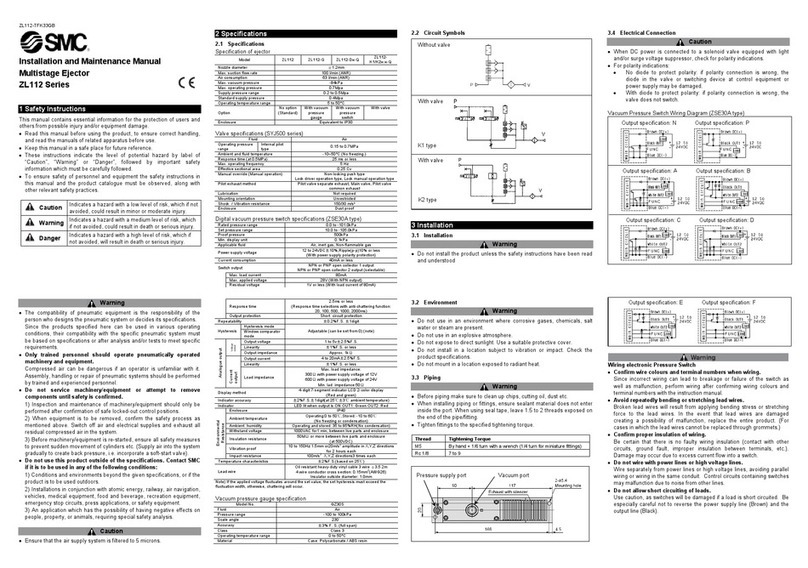
SMC Networks
SMC Networks ZL112 Installation and maintenance manual
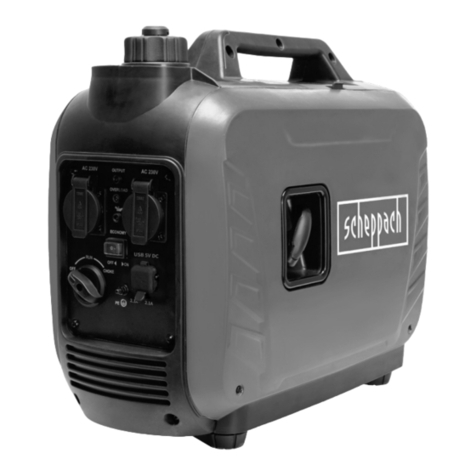
Scheppach
Scheppach SG2500i Translation of original instruction manual
